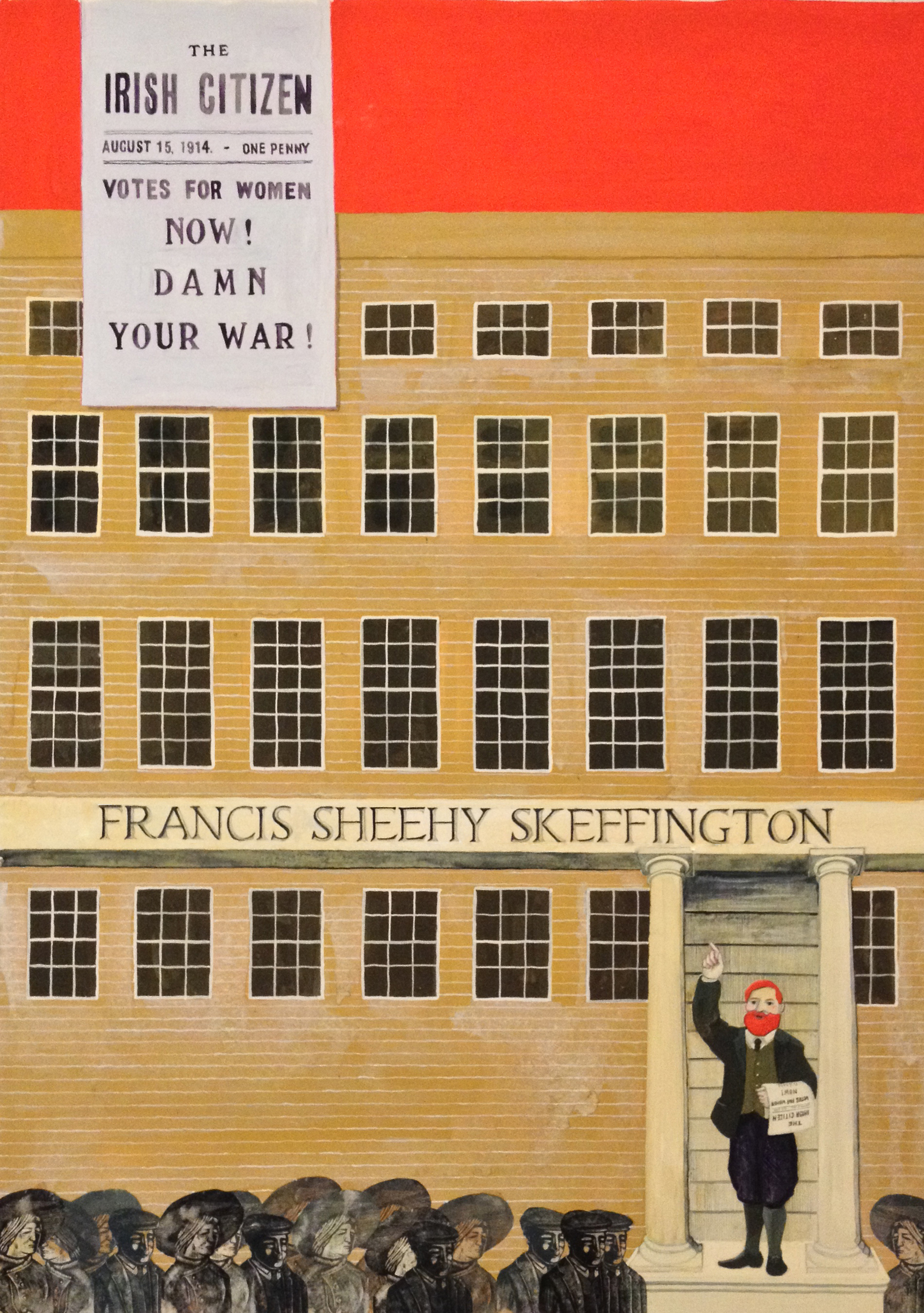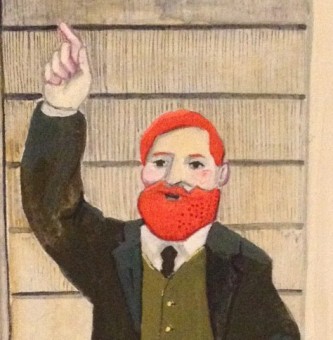 Sentenced to six months hard labor and a further six months if he failed to produce £50 bail, the small red-bearded gentleman wearing the ‘Votes for Women’ badge had been defiant. To loud cheering from the public gallery he had declared: ‘I will serve no such sentence. I will eat no food from this moment, and long before the expiration of the sentence I shall be out of prison, alive or dead!’ [2]
Sentenced to six months hard labor and a further six months if he failed to produce £50 bail, the small red-bearded gentleman wearing the ‘Votes for Women’ badge had been defiant. To loud cheering from the public gallery he had declared: ‘I will serve no such sentence. I will eat no food from this moment, and long before the expiration of the sentence I shall be out of prison, alive or dead!’ [2]
At Mountjoy prison in the centre of Dublin, when it was his turn to be searched and given his prison clothing, he had buttoned up his coat and told the guards: ‘I’ll facilitate you in no way, I’ll obey no prison regulations, and I’ll take no food until I’m released.’ [3]
The prison Governor had advised him to work and thereby reduce his sentence ‘by good conduct and industry’. ‘I know a quicker way out,’ he replied. ‘I shall reduce my sentence by bad conduct and idleness!’ [4]
Seven days later, ‘a pale skeleton of his recent self’ [5], he was released under the Cat and Mouse Act, to be rearrested at the end of June.
Though he ‘ignored all the conditions of the license as to reporting [his] movements to the police’ [6] and continued to speak out against the war in both Ireland the United States [7], he was never recalled to complete his sentence.
The year was 1915, and the name of the gentleman with the beard and the badge was Francis Sheehy-Skeffington.
‘A small instrument that makes revolutions’
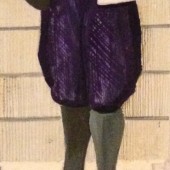 The poet and Irish nationalist Padraic Pearse, who was executed by the British in 1916 for his part in the failed Easter Rising, said of Sheehy-Skeffington that: ‘He had a thousand principles, from pacifism and women’s suffrage to wearing knickerbockers, and would die at the stake for the least of them, even his right to wear knickerbockers.’ [8]
The poet and Irish nationalist Padraic Pearse, who was executed by the British in 1916 for his part in the failed Easter Rising, said of Sheehy-Skeffington that: ‘He had a thousand principles, from pacifism and women’s suffrage to wearing knickerbockers, and would die at the stake for the least of them, even his right to wear knickerbockers.’ [8]
A small wiry man, not much over five feet five, with a reddish-brown beard and ‘always dressed in a rough gray tweed suit with knickerbockers, long stockings, boots at least one size too large for his feet, and, as time went on, a large button in his lapel proclaiming ‘Votes for Women”, he cut a distinctive, if eccentric, figure on the streets of Dublin. [9]
A vegetarian, anti-vivisectionist, anti-clerical, teetotaller and non-smoker – who made a point of denouncing the last two habits in others [10] – his life was dominated by ‘four causes’ [11]: feminism, pacifism, socialism and Irish nationalism. To those who branded him a crank he would respond: ‘Yes, that’s right, and a crank is a small instrument that makes revolutions.’ [12]
Always on the generous side
Nonetheless, he was very far from being an isolated or marginal figure. A contemporary and friend of both James Joyce and James Connolly, he was awarded the Chancellor’s Gold Medal by the Royal University of Ireland, was the first lay registrar of University College Dublin, helped to found the Independent Labour Party of Ireland, was at various times the Irish correspondent for L’Humanite and the Manchester Guardian, and was elected vice-President of the Irish Citizen’s Army. [13]
Writing in 1916, James Stephens noted that Sheehy-Skeffington had ‘been in every trouble that has touched Ireland these ten years back, and he has always been in on the generous side, therefore, and naturally, on the side that was unpopular and weak. It would seem that a cause had only to be weak to gain his sympathy, and his sympathy never stayed at home.’ [14]
Though Francis and his wife Hanna struggled financially ‘there was a joyouness in their manner of living which the more worldly and more outwardly comfortable people entirely miss’. [15]
‘Are you going to emancipate them?’
A strong feminist before his 1903 marriage, he and Hanna ‘each took the other’s surname as a gesture of belief in equal status for women’. [16]
In 1908 Hanna co-founded the Irish Women’s Franchise League (IWFL), the militant wing of the Irish suffrage movement, and was repeatedly jailed – and went on hunger strike – for her suffrage activism. [17] In 1912 Francis co-founded – and became the editor of – the IWFL’s newspaper, the Irish Citizen, whose stated mission was ‘to win for men and women equally the rights of citizenship’. [18]
In July 1912, with Hanna in prison for window-breaking, Francis enlisted the services of the Dublin-based actor Dudley Digges to help disguise himself as ‘a meek-looking little parson’ in order to infiltrate a packed Dublin meeting addressed by the Prime Minister, Herbert Asquith. Despite careful screening of the audience to try and prevent suffrage activists from causing disruption, Skeffington and three others managed to get in. ‘What about the women of Ireland? Are you going to emancipate them?’ he managed to shout, before being removed from the hall. [19]
‘Branches of the same tree’
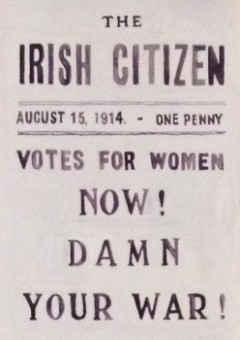 Long an ardent pacifist [20], Skeffington viewed war and anti-feminism as ‘branches of the same tree – disregard of true life-values’ [21]. Moreover, he was not impressed by Britain’s hypocritical condemnations of German aggression. He regarded ‘Prussianism’ as ‘simply the same imperialistic policy that caused France’s grip on Morocco, Russia’s on Catholic Galacia, Britain’s on Egypt, or the Boers, or Ireland’. [22]
Long an ardent pacifist [20], Skeffington viewed war and anti-feminism as ‘branches of the same tree – disregard of true life-values’ [21]. Moreover, he was not impressed by Britain’s hypocritical condemnations of German aggression. He regarded ‘Prussianism’ as ‘simply the same imperialistic policy that caused France’s grip on Morocco, Russia’s on Catholic Galacia, Britain’s on Egypt, or the Boers, or Ireland’. [22]
It is therefore perhaps unsurprising that less than a fortnight after Britain’s declaration of war, the Irish Citizen had produced a small poster bearing the immortal slogan: ‘Votes for Women Now! Damn Your War!’ [23] The poster generated some complaints – mainly because of the use of the world ‘damn’ – but also enough interest to justify a reprinting.
In a 12 September 1914 article entitled ‘War and Feminism’, Skeffington declared that: ‘If we want to stop war, we must begin by stopping this war … The best way to do that is to stop recruiting’. [24] And he now went about doing this with all of the passion he devoted to his other causes.
Beresford place
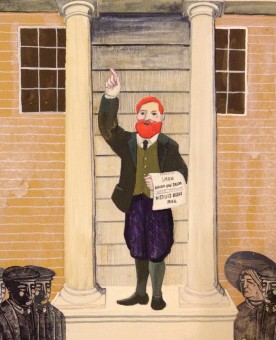 On 25 September, Asquith was to address a recruiting meeting in Dublin’s famous Mansion House, alongside the leader of the Irish Parliamentary Party, John Redmond. [25] A plot was hatched ‘to seize the Mansion House on the night before [the meeting] and hold it by armed force for twenty-four hours to prevent the meeting being held.’ Sheehy-Skeffington volunteered to take part and over a hundred members of the Irish Citizen Army and the Irish Volunteers were assembled before the action was called off at the last minute owing to the Mansion House having been turned into ‘an armed fortress’. [26]
On 25 September, Asquith was to address a recruiting meeting in Dublin’s famous Mansion House, alongside the leader of the Irish Parliamentary Party, John Redmond. [25] A plot was hatched ‘to seize the Mansion House on the night before [the meeting] and hold it by armed force for twenty-four hours to prevent the meeting being held.’ Sheehy-Skeffington volunteered to take part and over a hundred members of the Irish Citizen Army and the Irish Volunteers were assembled before the action was called off at the last minute owing to the Mansion House having been turned into ‘an armed fortress’. [26]
In the Autumn of 1914 he also began speaking out against the war every Sunday at Beresford Place, ‘standing in a little niche of stone under the railway bridge at the Custom House, close to Liberty Hall’. [27]
Across the country ‘[a]nti-recruitment activity began in early September [1914] … and reached its peak in October’, with nineteen occasions of clergymen using ‘seditious or anti-recruiting language’ being reported to Dublin Castle between August and October. [28] However, ‘[b]y the end of 1914 … popular opinion was on Britain’s side in the war’ and the campaign was dying down, with only four anti-English sermons reported in November, and only one in December. [29]
Despite the fact that the country was on the brink of civil war at the war’s outset, large numbers of Irishmen from both north and south enlisted, and ‘[b]y December 1914, around 50,000 Irishmen had been recruited’. [30] Moreover, even in Belfast ‘the most polarized Irish city politically, similar levels of volunteering occurred on both sides’ during 1914. [31]
Undeterred, Skeffington continued to speak out every Sunday. ‘If I thought I was in danger of becoming popular, I would examine my conscience’, he would later explain in another context. [32]
In all he would deliver 40 such speeches at Beresford Place, ‘analysing in logical fashion the war situation’, until he was finally arrested on 29 May 1915 for ‘mak[ing] statements likely to cause disaffection to His Majesty, the King, and likely to prejudice recruiting for His Majesty’s Forces’. [33]
‘A sentence upon British rule in Ireland’
Representing himself, Sheehy-Skeffington explained that ‘For twenty or thirty weeks I have pledged audiences of from 500 to 1,000 that they would passively resist conscription’, echoing Thoreau by claiming that if ‘there were only 100 who will keep the pledge … that 100 is enough to kill Conscription in Ireland. Whatever happens to me, the work is done.’ [34]
He closed his defence by declaring that:
‘This prosecution would be intelligible in a country ruled by an autocrat, in a country under the iron heel of military despotism; in a country ruled by a narrow oligarchy fearing the smallest breath of criticism. It would be intelligible above all in a country held by force by another country, the rulers of which would fear to allow any expression of opinion amongst the subject people. If you condemn me, you condemn the system you represent as being some or all of these things. Any sentence you may pass on me is a sentence upon British rule in Ireland.’ [35]
Nonviolent revolution
Skeffington was not only a practioner of active nonviolence, but also an advocate of nonviolent revolution.
On 22 May 1915, one week before his arrest, he published an open letter to the the poet and university lecturer Thomas MacDonagh, after the latter – who was then a leader in the (armed) Irish Volunteers – had addressed an IWFL meeting called to protest against the British government’s attempts to sabotage the Women’s International Conference in the Hague.
Noting that he had almost joined the Volunteers himself in September 1914, he wrote: ‘I am glad now I did not. For, as your infant movement grows towards the stature of a full-grown militarism, its essence – preparation to kill – grows more repellent to me.’ [36]
He was not advovating ‘servile lazy acquiescence’, but wanted to see the ‘age-long fight against injustice clothe itself in new forms, suited to a new age’:
‘Can you not conceive of an organisation, a body of men and women banded together to secure and maintain the rights and liberties of the people of Ireland, a body animated with a high purpose, united by a bond of comradeship, trained and disciplined in the ways of self-sacrifice and true patriotism, armed and equipped with the weapons of intellect and of will that are irresistable? – an organisation of people prepared to dare all things for their object, prepared to suffer and to die rather than abandon one jot of their principles – but an organisation that will not lay it down as its fundamental principle: ‘We will prepare to kill our fellow men’?’
MacDonagh, at least, could not: he would be executed the following year for his part in the Easter Rising.
The Citizen’s Army
‘Despite his pacifist beliefs Skeffington never missed an opportunity to co-operate with those who believed in the use of physical force, nor did he [ever] sink to self-righteous condemnations of their beliefs.’ [37]
In 1913 he was elected a vice-chairman of the Irish Citizen Army (ICA), ‘an army without rifles or uniforms’ formed to defend the workers from the police during a brutally-repressed lock-out involving thousands of workers in Dublin. [38]
Initially, ‘its members marched with hurleys’, the wooden sticks used in hurling, and helped to prevent evictions. [39] Skeffington ‘approved of [the ICA] as long as its sole purpose was to defend the workers against the police; when it became an armed military organisation, he left it.’ [40]
‘Some of us think it was a good thing’
Though he did not take part in it [41], Skeffington was detained by the British military during the 1916 Easter Rising and summarily executed. Two days before his death he had braved ‘a hail of bullets’ to try and rescue a wounded British soldier, explaining: ‘I could not let anyone bleed to death while I could help.’ [42]
When he learned of Skeffington’s murder, Major Ivor Price, the Director of Military Intelligence in Ireland is reported to have said: ‘Some of us think it was a good thing that Sheehy-Skeffington was put out of the way, anyhow’. [43]
In his last hours, detained, imprisoned, threatened with execution, and witness to the murder of a teenage boy (which he protested against), Skeffington apparently ‘showed no fear, no fear at all’. [44]
The Anti-Conscription Campaign
Skeffington did not live to see the many causes that he espoused succeed. Many of them are still works in progress.
However, had he lived another 26 months he would at least have seen some of his claims concerning conscription and civil resistance partially vindicated.
On 9 April 1918 British Prime Minister Lloyd George introduced the Military Service Bill, raising the age limit in Britain and providing for conscription in Ireland. The latter had been exempted when conscription was brought in in Britain in 1916, on the grounds that it was too politically sensitive.
Nationalists in Ireland responded with fury, with both the Irish Parliamentary Party and the Catholic Hierarchy ‘unanimously hostile’, and on Sunday 21 April 1918 ‘some two million people’ signed a pledge to resist conscription backed by the Catholic bishops. [45] Working-class loyalists protested too, with a huge crowd of 8,000 gathering on the steps of the Custom House to condemn the Bill.
On 23 April 1918 a general strike brought ‘virtually the whole of Ireland to a standstill except the loyalist areas of the northeast’ and on 9 June 1918 women throughout the country signed a pledge stating ‘that they would not take jobs vacated by men being conscripted’. [46]
By 20 June 1918 the Government had dropped its conscription plans. [47]
NOTES
[1] Leah Levenson, With Wooden Sword: A Portrait of Francis Sheehy-Skeffington, Militant Pacifist, Northeastern University Press, 1983, p. 249
[2] Owen Sheehy-Skeffington, ‘Francis Sheehy-Skeffington, 23 December 1878 – 26 April 1916’, p.142 in Owen Dudley Edwards & Fergus Pyle (eds), 1916: The Easter Rising, MacGibbon & Kee, 1968; Leah Levenson, op. cit., p. 177.
[3] Ibid. According to Levenson, the ‘Votes for Women’ badge was taken from him at this stage.
[4] Hanna Sheehy-Skeffington, ‘An Irish Pacifist’, p. 342, in Julian Bell (ed), We Did Not Fight. 1914-1918 experiences of war resisters, Cobden-Sanderson, 1935.
[5] Owen Sheehy-Skeffington, op. cit., p. 143. The sources cited above disagree about the exact chronology of Sheehy-Skeffington’s arrest and trial, with Hanna giving the date of his arrest as ‘midnight on May 31st’ and Owen having him released after 10 (not 7) days (Hanna Sheehy-Skeffington, op. cit., p. 339; Owen Sheehy-Skeffington, op. cit.). There are good reasons to go with Levenson’s chronology, which we adopt here eg. 31 May 1915 was a Monday, not a Saturday!
[6] Francis Sheehy-Skeffington, A Forgotten Small Nationality: Ireland and the War, The Donnelly Press, p. 16, https://openlibrary.org/books/OL7025972M/A_forgotten_small_nationality.
[7] Skeffington left for the US in July 1915, where he stayed for four months, writing and speaking. His friend J.F. Byrne later claimed that Skeffington had also gone ‘to carry out an underground assignment for the Neutrality League – namely, contact with Germany’ (Levenson, op. cit., p. 182). Offered a post on the New York Weekly he refused saying: ‘I would rather be in jail in Ireland than free in New York’ (Hanna Sheehy-Skeffington, op.cit., p. 343). In a similar vein he told an American reporter: ‘I think they were glad to get me out of the country, so I’m going back in November’ (Levenson, op. cit., p. 182).
[8] Liz Curtis, The Cause of Ireland: From the United Irishmen to Partition, Beyond the Pale Publications, 1984, p. 203.
[9] ‘reddish-brown beard’, Roger McHugh, ‘Thomas Kettle and Francis Sheehy-Skeffington’, p. 125 in Conor Cruise O’Brien, The Shaping of Modern Ireland, Routledge and Keegan Paul, 1960; ‘always dressed’, Levenson, op. cit., p. 15.
[10] Levenson, op. cit., p. 18. According to Roger McHugh, during their honeymoon, he and his wife Hanna visited one of her favourite uncles, who had been warned off drinking alcohol by his doctor. Discovering a full bottle of whiskey on the premises, he proceeded to pour it down the sink, declaring that ‘he would do everything possible to prevent her uncle’s death’. ‘Her uncle carried this preventive logic a stage further by showing them both out’, McHugh notes dryly. (McHugh, op. cit., pp. 132-133). ‘anti-clerical’, Hanna Sheehy-Skeffington, op. cit., p. 339.
[11] Owen Sheehy-Skeffington, op. cit., p. 140.
[12] Levenson, op. cit., p. 95.
[13] Owen Sheehy-Skeffington, op. cit., p.138; Hanna Sheehy-Skeffington, op. cit., p. 339; McHugh, op. cit., pp. 128, 135; Levenson, op. cit., pp. 23 – 29, 37, 45.
[14] James Stephens, The Insurrection in Dublin, Colm Smyth Ltd, 1992 [first edition 1916], pp. 50 – 51.
[15] Levenson, op. cit., p. 72.
[16] Owen Sheehy-Skeffington, op.cit., p. 137.
[17] Levenson, op. cit., pp. 79, 126 – 130, 154 – 155. In August 1911 Francis Sheehy-Skeffington told a mass meeting of the Daughters of Erin and the Socialist Party of Ireland that ‘no progressive movement can be in a healthy state unless its members are prepared to face the risk of imprisonment’ (Levenson, op. cit., p. 123).
[18] Levenson, op. cit., p. 124. The Citizen was also committed to assisting all movements that worked for the fullest development of ‘a complete humanity’ and opposing everything that tended to ‘lower or limit human freedom’.
[19] Levenson, op.cit., pp. 126, 130. In November he disguised himself again – this time ‘wearing evening clothes, a bowler hat, and a long overcoat, with his cheeks rouged and his whiskers whitened’ – in order to infiltrate a meeting addressed by the Conservative and Ulster Unionist leaders Bonar Law and Edward Carson. Hanna was arrested after the meeting, and sentenced to a week’s imprisonment after she was assaulted by a police officer (Levenson, op. cit., pp. 153 -154).
[20] In 1899 Sheehy-Skeffington set up a table at the entrance to one of University College Dublin’s buildings and began collecting signatures in support of the Russian Tsar’s call for an International Peace Conference to ‘put an end to these incessant armaments, and to seek the means of warding off the calamities that are threatening the whole world’ – an action for which he was mocked in Joyce’s Stephen Hero. (Levenson, op. cit., p. 27; T.J. Lawrence, ‘The Tsar’s Rescript’, International Journal of Ethics, Vol. 9, No. 2, January 1899, p. 137). According to Margaret MacMillan, ‘The tsar seems to have been motivated partly by idealism and also by the practical consideration that Russia was having trouble in keeping up with the spending of other European powers’ (Margaret MacMillan, The War that Ended Peace: How Europe Abandoned Peace for the First World War, Profile Books, 2014, p. 279). Other radicals were less enthusiastic than Sheehy-Skeffington about the Great Powers’ pre-war peace initiatives. For example, Rosa Luxemburg not unreasonably attacked British foreign secretary Edward Grey’s May 1911 proposal for an international agreement to end the arms race: ‘If the Europeans were serious, she said, they would give up their colonies and end their policy of carving out spheres of influence throughout the world. If they were not prepared to do that, rhetoric about limiting arms as a means of preventing conflict was fraudulent.’ (Harry Harmer, Rosa Luxemburg, Haus Publishing, 2008, pp. 82 – 83).
[21] Levenson, op. cit., p. 168, quoting an 8 August 1914 Irish Citizen editorial. The latter continued: ‘It is not a coincidence that all the countries concerned in the war are countries which do not recognise women as citizens, and that those which are most aggressively and unscrupulously war-like are precisely those in which women are held in the least regard. It is no mere coincidence that it is those who support women’s claim to freedom who are, in every country, the most active in trying to prevent war or to limit its consequences’.
[22] McHugh, op. cit., p. 136. ‘[O]ur enemy is not German militarism, but English militarism – Kitchenerism’, he would later declare (Catriona Pennell, A Kingdom United: Popular Responses to the Outbreak of the First World War in Britain and Ireland, Oxford University Press, 2014, p. 184).
[23] Dated 15 August 1914, a photo of the poster can be viewed online in the catalogues of the National Library of Ireland: http://catalogue.nli.ie/Record/vtls000506672.
[24] Levenson, op.cit., p. 244.
[25] William O’Brien, Forth the Banners Go, The Three Candles Ltd, 1969, p. 271. On 3 August 1914 Redmond had made a speech ‘urg[ing] the government to leave the defence of the Irish shores to the Irish National and Ulster Volunteers … reflect[ing] the feelings of the vast majority of nationalists of ‘all schools and sects” (Pennell, op. cit., p. 178). However, the following month, on 17 September, Redmond issued a second statement, extending Irish nationalists’ commitment to the war beyond Ireland’s shores, leading to a split in the Irish Volunteers, the overwhelming majority of whom sided with Redmond (ibid., pp. 182 – 183).
[26] Levenson, op. cit., p. 166. Unable to occupy the Mansion House Skeffington was instead ‘brutally beaten by the police’ whilst attempting to address a crowd outside the cordoned-off area. This was far from the only occasion on which he was physically attacked for his activism. In 1916 James Stephens wrote: ‘There are multitudes of men in Dublin of all classes and creeds who can boast that they kicked Sheehy-Skeffington, or that they struck him on the head with walking sticks and umbrellas, or that they smashed their fists into his face, and jumped on him when he fell. It is by no means an exaggeration to say that these things were done to him, and it is true that he bore ill-will to no man …’ (James Stephens, op. cit., p. 51). Levenson provides two further examples: (1) In November 1913 Skeffington was assaulted and had the tyres of his bicycle slashed whilst attempting to help some of the children of the locked-out transport workers leave the country for temporary homes in England, during the Dublin Lock-out of 1913/1914. Typically, he refused to press charges against his assailants on the grounds that they were ‘merely the dupes of more astute persons in the background’ (Levenson, op. cit., p. 147). (2) During a demonstration near Mountjoy prison during Hanna’s second imprisonment there in 1913, Skeffington was ‘grabbed … by the throat’ and ‘roughly handled’ by members of the police (Levenson, op. cit., p. 155).
[27] Hanna Sheehy-Skeffington, op.cit., pp. 340-341.
[28] Pennell, op. cit., pp. 185-186. According to historian Tim Bowman, ‘The main propaganda techniques used by those opposed to recruiting were to interrupt recruiting meetings and to circulate pamphlets’. It appears that many of the recruiters were lousy speakers and did not respond well to hecklers: ‘In May 1915, in Wexford, Henry McLaughlin, faced by a heckler, simply stated, ‘There is a man who ought to be with the Germans cutting off little babies’ hands.’ Meanwhile, confronted by a heckler in Enniscorthy, in March 1915, Capt W.A. Redmond, MP, simply walked out of the meeting.’ (Tim Bowman, ‘The Irish Recruiting Campaign and Anti-Recruiting Campaigns, 1914 – 1918’ in Taithe & Thornton, Propaganda: Political Rhetoric and Identity, 1300 – 2000, pp. 232 – 233). In Bowman’s judgement ‘The anti-recruiting campaign appears to have had ‘little apparent impact … during the First World War’ (ibid., p. 234).
[29] Pennell, op. cit., pp. 187-188. Hanna Sheehy-Skeffington decribes Dublin as being ‘war-mad’ during this time (Hanna Sheehy-Skeffington, op. cit., p. 340).
[30] Pennell, op. cit., p.186, 190. According to Pennell, ‘It is one of the paradoxes of modern Irish history that the outbreak of war in Europe may have prevented civil war in Ireland in 1914’ (ibid., p. 165).
[31] Ibid., p. 191. In total 300,000 Irishmen – five-sixths of them Catholics – served with the British forces during WW1, of whom 49,000 were killed. (Curtis, op. cit., p. 302).
[32] Levenson, op. cit., p. 212. The context was his continued adherence to pacifism, in the face of nationalist opposition (see below).
[33] ‘analysing’, Hanna Sheehy-Skeffington, op. cit., pp. 340 – 341; ‘mak[ing] statements’, Levenson, op. cit., p. 175.
[34] Levenson, op. cit., pp. 248 – 249. In his 1849 essay ‘Civil Disobedience’ (also know as ‘Resistance to Civil Government’) Thoreau famously wrote: ‘I know this well, that if one thousand, if one hundred, if ten men whom I could name, — if ten honest men only, — aye, if one HONEST man, in this State of Massachusetts, ceasing to hold slaves, were actually to withdraw from this copartnership, and be locked up in the county jail therefor, it would be the abolition of slavery in America. For it matters not how small the beginning may seem to be: what is once well done is done for ever.’ (Henry David Thoreau, Walden and Other Writings, Bantam Classic, 1982, p.93, emphasis in original; the online version of the text is available at http://sniggle.net/TPL/index5.php?entry=rtcg#p21). The allusion may well have been deliberate: Hanna had quoted Thoreau in a statement about her window-smashing suffrage action that was printed in the Irish Citizen (Levenson, op. cit., p. 127).
[35] Levenson, op. cit., p. 177.
[36] ‘You are not out to exploit or to oppress’, he acknowledged, ‘you are out merely to prevent exploitation and to defend.’ But ‘What militarism ever avowed other aims – in its beginnings?’ (Francis Sheehy-Skeffington, ‘An Open Letter to Thomas MacDonagh’, Irish Citizen, 22 May 1915, reprinted in Edwards & Pyle, op. cit., MacGibbon & Kee, 1968. All of the quotes from the letter that follow are taken from this source.)
[37] Simon Donohoe, ‘Nonviolent political action and Irish politics in the early Twentieth Century’, in ‘Nonviolence in Irish History’, DAWN, 1978, www.innatenonviolence.org/pamphlets/nonviolence.pdf
[38] McHugh, op. cit., p. 135; Donal Nevin, ‘The Irish Citizen Army’, p.121 in Edwards & Pyle, op. cit.
[39] Ibid. Nevin notes that as late as July 1914 the ICA only had ‘one Lee Enfield Rifle and a number of revolvers’ (ibid., p. 124).
[40] McHugh, op.cit. Sheehy-Skeffington also ‘deplored [the ICA’s] lack of a positive position in support of the women’s movement’ (Levenson, op. cit., p. 157).
[41] While Sheehy-Skeffington’s sympathies were clearly with the Rising’s aims, he did not approve of it. Just a few days before his murder he told his close friend J.F. Byrne ‘that he would rather be shot than shoot at anyone’ (Leveson, op. cit., pp. 210, 216).
[42] Levenson, op. cit., pp. 216-217, 224 – 225.
[43] Ibid., p. 229.
[44] Ibid., p. 224, quoting a soldier who had taken part in an evening raid the night before, which a bound Sheehy-Skeffington had accompanied as a hostage.
[45] Curtis, op. cit., pp. 299 – 300. Dublin protestants organised their own petition.
[46] Ibid., op. cit., pp. 300 – 301.
[47] Thomas Hennessey, Dividing Ireland: World War 1 and Partition, Routledge, 1998, p. 228. The shelving of the plans did not produce a state of quiescence. On 9 July 1918 the Defence of the Realm Act was used to ban ‘all meetings and processions in public places in the whole of Ireland. Concerts, hurling matches, and literary competitions were suppressed.’ In response ‘1,500 hurling matches were played on 4 August, and on 15 August hundreds of public meetings were held, with speakers being jailed as a result.’ Over 500 political arrests were made between mid-May and mid-December. (Curtis, op. cit., p. 302).

